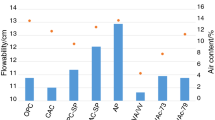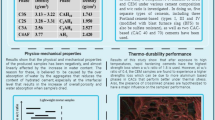Abstract
Although acrylic polymer emulsions have been reported to impart many desirable attributes to cement mortar; delayed hydration, excessive air entrapment and moisture induced loss of strength have been highlighted as constraints. This paper explores the utilization of hydrated calcium chloride blended-acrylic polymer emulsion (CP) as a mitigation measure to these aforementioned drawbacks. First, the effects of 0, 0.5, 1.0 and 1.5% of CP by mass of cement on the early-age cement paste hydration and mortar flow were investigated. Thereafter, the influence of CP on the hardened porosity, moist-cured compressive strength, initial rate of capillary water absorption and rapid chloride permeability (RCPT) were evaluated. Test results indicate that the addition of CP to pastes sped up the cement hydration process, accelerating the final setting time of pastes by approximately 0.5–1.5 h as the CP content of pastes increased. Moreover, CP slightly increased the flow of fresh mortar, the hardened porosity of mortar mixtures containing 0.5 and 1.0% CP were also comparable to those of the plain reference mortar. With the exception of the 1.5% CP blended mortar, the 14 days moist-cured compressive strength of 0.5–1.0% CP blended mortar mixtures were also comparable to that of the plain reference mixture. Relative to the reference mixture, the addition of CP to mortar reduced the initial rate of capillary water absorption of mortar, with the mixture containing 1.5% CP giving a maximum reduction of 23%. Conversely, RCPT results indicate that above 0.5% CP addition level, CP generally increased the electrical conductivity of mixtures.






Similar content being viewed by others
References
Paiva H, Silva L, Labrincha J, Ferreira V (2006) Effects of a water-retaining agent on the rheological behaviour of a single-coat render mortar. Cem Concr Res 36(7):1257–1262
Ohama Y (1998) Polymer-based admixtures. Cem Concr Compos 20(2–3):189–212
Anagnostopoulos CS (2007) Cement-clay grouts modified with acrylic resin or methyl methacrylate ester: physical and mechanical properties. Constr Build Mater 21:252–257
Afridi MUK, Chaudhary ZU, Ohama Y, Demura K, Iqbal MZ (1994) Strength and elastic properties of powdered and aqueous polymer-modified mortars. Cem Concr Res 24:1199–1213
Fu X, Chung DDL (1996) Effect of polymer admixtures to cement on the bond strength and electrical contact resistivity between steel fiber and cement. Cem Concr Res 26:189–194
Kim J-H, Robertson RE (1998) Effects of polyvinyl alcohol on aggregate-paste bond strength and the interfacial transition zone. Adv Cem Based Mater 8:66–76
Lavelle JA (1988) Acrylic latex-modified Portland cement. ACI Mater J 85:41–48
Zhong S, Chen Z (2002) Properties of latex blends and its modified cement mortars. Cem Concr Res 32:1515–1524
Aggarwal LK, Thapliyal PC, Karade SR (2007) Properties of polymer-modified mortars using epoxy and acrylic emulsions. Constr Build Mater 21:379–383
Montanaro L, Festa D, Bachiorrini A, Penati A (1990) Influence of added polymer emulsions on the short-term physical and mechanical characteristics of plastic mortar. Cem Concr Res 20:62–68
Knapen E, Van Gemert D (2009) Cement hydration and microstructure formation in the presence of water-soluble polymers. Cem Concr Res 39:6–13
Kong X, Emmerling S, Pakusch J, Rueckel M, Nieberle J (2015) Retardation effect of styrene-acrylate copolymer latexes on cement hydration. Cem Concr Res 75:23–41
Kong X, Pakusch J, Jansen D, Emmerling S, Nieberle J, Goetz-Neuhoeffer F (2016) Effect of polymer latexes with cleaned serum on the phase development of hydrating cement pastes. Cem Concr Res 84:30–40
Wang R, Wang PM (2010) Function of styrene-acrylic ester copolymer latex in cement mortar. Mater Struct 43(4):443–451
Knapen E (2007) Microstructure formation in cement mortars modified with water-soluble polymers. Dissertation, K.U. Leuven
Knapen E, Van Gemert D (2015) Polymer film formation in cement mortars modified with water-soluble polymers. Cem Concr Compos 58:23–28
Colville J, Amde AM, Miltenberger M (1999) Tensile bond strength of polymer modified mortar. J Mater Civ Eng 11(1):1–5
Jenni A, Zurbriggen R, Holzer L, Herwegh M (2006) Changes in microstructures and physical properties of polymer-modified mortars during wet storage. Cem Concr Res 36:79–90
Knapen E, Van Gemert D (2009) Effect of under water storage on bridge formation by water-soluble polymers in cement mortars. Constr Build Mater 23:3420–3425
Juenger MCG, Monteiro PJM, Gartner EM, Denbeaux GP (2005) A soft X-ray microscope investigation into the effects of calcium chloride on tricalcium silicate hydration. Cem Concr Res 35:19–25
American Society of Concrete Contractors (ASCC) (2017) Position statement #31—acceptable use of calcium chloride in concrete. Retrieved on February 27, 2017 from: https://www.ascconline.org/Portals/0/docs/POSITION-STATEMENTS/PS-31-acceptable-use-calcium-chloride-concrete.pdf
Singh NK, Mishra PC, Singh VK, Narang KK (2003) Effects of hydroxyethyl cellulose and oxalic acid on the properties of cement. Cem Concr Res 33:1319–1329
American Society of Testing and Materials (ASTM) C305 (2014) Standard practice for mechanical mixing of hydraulic cement pastes and mortars of plastic consistency. ASTM International, West Conshohocken, PA, ASTM C305–14
ASTM C1753 (2015) Standard practice for evaluating early hydration of hydraulic cementitious mixtures using thermal measurements. ASTM International, West Conshohocken, PA, ASTM C1437–15
ASTM C1437 (2015) Standard test method for flow of hydraulic cement mortar. ASTM International, West Conshohocken, PA, ASTM C1437–15
ASTM C642 (2013) Standard test method for density, absorption, and voids in hardened concrete. ASTM International, West Conshohocken, PA, ASTM C642–13
ASTM C39 (2016) Standard test method for compressive strength of cylindrical concrete specimens. ASTM International, West Conshohocken, PA, ASTM C39–16
ASTM C1202 (2012) Standard test method for electrical indication of concrete’s ability to resist chloride ion penetration. ASTM International, West Conshohocken, PA, ASTM C1202–12
Tian Y, Jin X, Jin N (2013) Research on the microstructure formation of polyacrylate latex modified mortars. Constr Build Mater 47:1381–1394
Ramachandran VS (1971) Possible states of chloride in the hydration of tricalcium silicate in the presence of calcium chloride. Mater et Constr 4(19):3–12
Du L, Folliard KJ (2005) Mechanism of air entrainment in concrete. Cem Concr Res 35:1436–1471
Ramachandran V, Feldman R (1978) Time-dependent and intrinsic characteristics of portland cement hydrated in the presence of calcium chloride. Cemento 75(3):311–322
Suryavanshi A, Scantlebury J, Lyon S (1995) Pore size distribution of OPC and SRPC mortars in presence of chlorides. Cem Concr Res 25(5):980–988
Kishar EA, Ahmed DA, Mohammed MR, Noury R (2013) Effect of calcium chloride on the hydration characteristics of ground clay bricks cement pastes. Beni-Suef Univ J Basic Appl Sci 2(1):20–30
Kim J-H, Robertson RE (1997) Prevention of air void formation in polymermodified cement mortar by pre-wetting. Cem Concr Res 27(2):171–176
Haque MN (1980) Properties of concrete with and without calcium chloride during drying and wetting. Cem Concr Res 10(3):377–385
Torkittikul P, Chaipanich A (2012) Optimization of calcium chloride content on bioactivity and mechanical properties of white Portland cement. Mater Sci Eng C 32(2):282–289
Qomi MJA, Krakowiak KJ, Bauchy M, Stewart KL et al (2014) Combinatorial molecular optimization of cement hydrates. Nat Commun 5:1–9
Shaker FA, El-Dieb AS, Reda MM (1997) Durability of styrene–butadiene latex modified concrete. Cem Concr Res 27(5):711–720
Paiva H, Esteves LP, Cachim PB, Ferreira VM (2009) Rheology and hardened properties of single-coat render mortars with different types of water retaining agents. Constr Build Mater 23:1141–1146
Feldman R, Prudencio LR, Chan G (1999) Rapid chloride permeability test on blend cement and other concretes: correlations between charge, initial current and conductivity. Constr Build Mater 13:149–154
Acknowledgements
The authors extend their appreciation to the Polymerpave Global Corporation for providing the CaCl2-blended acrylic polymer emulsion used in this study.
Author information
Authors and Affiliations
Corresponding author
Ethics declarations
Conflict of interest
All authors declare that they have no conflict of interest.
Rights and permissions
About this article
Cite this article
Onuaguluchi, O., Ratu, R. & Banthia, N. The effects of CaCl2-blended acrylic polymer emulsion on the properties of cement mortar. Mater Struct 51, 50 (2018). https://doi.org/10.1617/s11527-018-1176-1
Received:
Accepted:
Published:
DOI: https://doi.org/10.1617/s11527-018-1176-1




